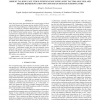Free Online Productivity Tools
i2Speak
i2Symbol
i2OCR
iTex2Img
iWeb2Print
iWeb2Shot
i2Type
iPdf2Split
iPdf2Merge
i2Bopomofo
i2Arabic
i2Style
i2Image
i2PDF
iLatex2Rtf
Sci2ools
ICASSP
2011
IEEE
2011
IEEE
Robust talking face video verification using joint factor analysis and sparse representation on GMM mean shifted supervectors
It has been previously demonstrated that systems based on block wise local features and Gaussian mixture models (GMM) are suitable for video based talking face verification due to the best trade-off in terms of complexity, robustness and performance. In this paper, we propose two methods to enhance the robustness and performance of the GMM-ZTnorm baseline system. First, joint factor analysis is performed to compensate the session variabilities due to different recording devices, lighting conditions, facial expressions, etc. Second, the difference between the universal background model (UBM) and the maximum a posteriori (MAP) adapted model is mapped into the GMM mean shifted supervector whose over-complete dictionary becomes more incoherent. Then, for verification purpose, the sparse representation computed by l1 -minimization with quadratic constraints is employed to model these GMM mean shifted supervectors. Experimental results show that the proposed system achieved 8.4% (group 1)...
Gaussian Mixture Models | GMM-ZTnorm Baseline | ICASSP 2011 | Signal Processing | Wise Local Features |
| Added | 21 Aug 2011 |
| Updated | 21 Aug 2011 |
| Type | Journal |
| Year | 2011 |
| Where | ICASSP |
| Authors | Ming Li, Shrikanth Narayanan |
Comments (0)

